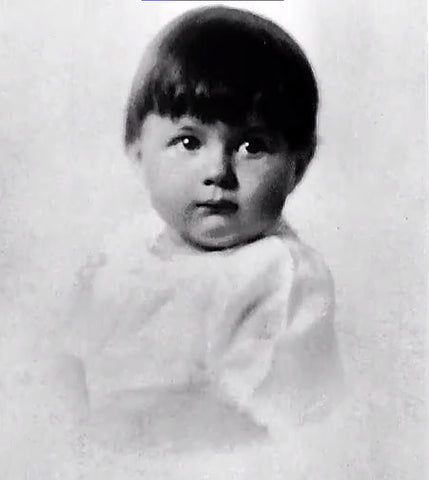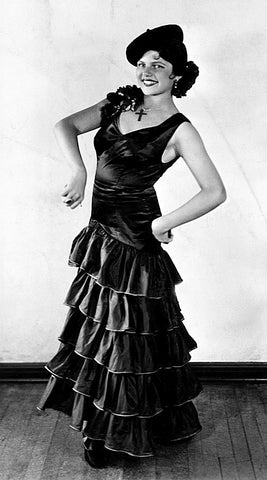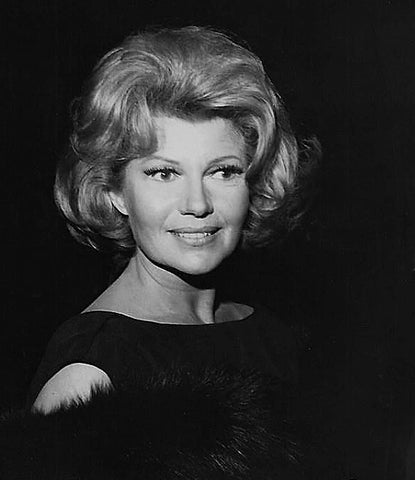Pandora Writer |
____________________

Rita Hayworth (born Margarita Carmen Cansino) was born on October 17, 1918, in Brooklyn, New York. She was born to parents Eduardo Cansino Sr. and Volga Hayworth, both of whom were professional dancers. Rita's father was of Spanish descent, while her mother had Irish and English roots. From an early age, Rita was exposed to the world of entertainment and started her career as a dancer, performing alongside her father in various vaudeville shows. The stage was a natural home for her, and she quickly developed an innate talent for dancing.
However, life was not without its challenges for young Rita. Her family struggled with financial difficulties, which were exacerbated by the Great Depression in the 1930s. The family relocated to Hollywood in search of better opportunities in the entertainment industry. In Hollywood, they continued performing, and Rita started to gain experience and recognition as a dancer in various nightclubs. At an early age, her family depended on her to provide for their livelihood, which included her parents and her two younger brothers.

Despite facing personal challenges, it was Hayworth's dynamic dancing that quickly drew attention. In an interview, Rita said, "I was dancing in a place in Mexico, with my father and some people from Fox Studios saw me dancing and asked my father if I could come up and dance in a picture for them. So he said yes."
Rita's journey to stardom was not without its share of setbacks. While she was undeniably talented, Hollywood's obsession with appearances and typecasting posed a significant challenge. She often found herself cast in supporting roles as dancers or femme fatales.
At just 16 years old, she was offered a contract and made her debut in the film "Dante's Inferno” under the name Rita Cansino. As the enigmatic Rita Cansino with her distinctive appearance, she proceeded to feature in several less memorable films such as "Human Cargo" in 1936.
To break free from her father's suffocating influence, she chose to elope when she was 17, tying the knot with Texan oil tycoon, Edward Judson. After Fox terminated her contract following five minor roles, Rita received a fresh opportunity through the astute and opportunistic efforts of her husband. This led to a new contract with Columbia Pictures.

It was at Columbia Pictures that Rita truly blossomed as an actress and a star. She became a favorite of studio head Harry Cohn, who saw in her the potential to become a major leading lady. They needed to rebrand her as a glamorous star, and they invested heavily in changing her image. Rita's black hair was dyed red, and she underwent electrolysis to further alter her hairline. They also changed her name from Margarita Cansino to Rita Hayworth. The transformation was remarkable, and the new Rita Hayworth, with her auburn locks and stunning features, quickly became a sensation.
Her initial notable role was as Judy McPherson in "Only Angels Have Wings" in 1939 with Cary Grant. She achieved her first significant success in "The Strawberry Blonde" in 1941. This role highlighted her versatility and helped her transition from supporting parts to more substantial roles. It was her captivating dance sequences alongside Fred Astaire in "You'll Never Get Rich" in 1941 that truly propelled her into stardom. Later that year, she appeared in "Blood and Sand.”

Throughout the 1940s, Rita Hayworth continued to shine on the big screen, appearing in a series of successful films. She was known for her dancing skills, and her background as a professional dancer lent grace and elegance to her performances. Notable films from this period include "Cover Girl" in 1944, in which she co-starred with her frequent collaborator, Gene Kelly. In 1944 Hayworth welcomed her first child, named Rebecca Welles. She was also in "The Lady from Shanghai" in 1947, directed by Orson Welles (whom she married in 1943).
One of her most iconic roles during this time was in "Gilda" in 1946, directed by Charles Vidor and co-starring Glenn Ford. Rita's performance in "Gilda" showcased her as more than just a pretty face; she demonstrated depth and emotional range as an actress.

Behind the glamorous facade of Rita Hayworth's Hollywood success lay a series of personal struggles. Her tumultuous marriages, particularly her marriage to Orson Welles, were often the subject of media attention. Her union with Welles was marked by both creative collaboration and intense conflict, which eventually led to their divorce in 1947.
Rita's struggles extended beyond her personal life. She faced the pressures of being a sex symbol and struggled with the demands of the Hollywood studio system. She was typecast in roles that often limited the full range of her acting abilities. These challenges, combined with a demanding work schedule, took a toll on her mental and physical health.
As the 1940s turned into the 1950s, Rita Hayworth's career began to wane. The decline was partly due to changing trends in the film industry, but it was also influenced by the personal challenges she faced.

Hayworth took time off from Hollywood to travel overseas and get away from it all. While in Europe, Hayworth met Prince Aly Khan. After a very public courtship, Hayworth remarried for the third time. The newlyweds settled in Europe, where Hayworth gave birth to her second daughter, Princess Yasmin Aga Khan, in 1949. Unfortunately, the royal lifestyle did not suit her. She returned to the U.S. after her split from Khan in 1951 and they officially divorced in 1953.
By the 1950s, Rita Hayworth's status as a top-tier Hollywood star had faded. She continued to make films, but her career was marked by a series of disappointments and setbacks. Her marriages and divorces continued to dominate headlines, and her roles became increasingly less significant. It was a challenging period for a woman who had once been one of the brightest stars in the industry.
One of the notable films from this period was "Salome" in 1953, a project that she was passionate about. Rita played the title role in this film, which combined elements of dance and drama. While the film had its merits, it did not achieve the success that Rita had hoped for, and it marked another disappointment in her career. In 1953, following another brief marriage, this time to the singer Dick Haymes, Hayworth took another hiatus from the Hollywood screen.

Hayworth wed producer James Hill in 1958. Together with Hill, she collaborated on the Oscar-nominated films "Separate Tables" in 1958 and "The Happy Thieves" in 1961. However, they divorced after three years. In a later role opposite John Wayne in "Circus World" in 1964, Hayworth's performance earned her a Golden Globe nomination.
Despite making appearances in a few films during the 1960s, her days as a leading lady were behind her. She grappled with early onset Alzheimer's disease, though an official diagnosis did not occur until 1980. Hayworth made her final film, "The Wrath of God," in 1972, but her struggle with remembering lines and maintaining focus had plagued her for several years. She chose to retire to a secluded life far removed from Hollywood.
At the age of 68, Hayworth succumbed to Alzheimer's, passing away on May 14, 1987 at the home of her daughter, Princess Yasmin Khan Embiricos. Rita Hayworth's passing marked the end of an era in Hollywood.

Rita's personal struggles, particularly her battle with Alzheimer's disease, have also left a lasting impact. Her daughter, Yasmin, has continued to raise awareness and funding for Alzheimer's research, and the Rita Hayworth Gala remains a significant event in this effort.

On May 18, 1987, a funeral Mass was conducted in her honor at the Roman Catholic Church of the Good Shepherd in Beverly Hills. More than 500 mourners, comprising luminaries from the world of film, fans, relatives, and friends, gathered in the church to pay their respects. In the eulogy, she was remembered as a "sweet, kind, gentle lady" who remained somewhat reserved, despite her on-screen fame.
Rita Hayworth's life reminds us that behind the glamour of Hollywood, there are often untold stories of sacrifice and struggle. From her modest start as a dancer to her ascent to Hollywood stardom, Hayworth's path was marked by both achievements and obstacles. Despite the ups and downs of her life, she remains an icon of classic Hollywood.
-----------------------------------------------------------------------------------------------------------
Did you know?
Before settling on "Rita Hayworth," she was born Margarita Carmen Cansino. Her name change was part of the studio's attempt to make her more marketable to a wider audience.

Hayworth was fluent in both English and Spanish. This bilingualism allowed her to act in both English and Spanish-language films, which expanded her career even further.
Eddie Judson hired publicist Henry Rogers to boost his wife's career. Rogers once remarked, "It appeared to me that Eddie would have readily traded his wife to the highest bidder if it had meant furthering her career."
She was Ginger Rogers' cousin.
In addition to her film career, she had success on Broadway, starring in the musical "Pal Joey" in 1940. This stage experience highlighted her versatility as a performer.

Her renowned red hair was not her natural hue. Her original hair color was black. When she was signed by the studio, executives determined that her hairline was too low on her forehead. To address this, she endured years of painful electrolysis treatments to raise it.
Her famous hairstyle in "Gilda" – a long, flowing mane of wavy hair – became a trend in the 1940s and was widely imitated by women.
During World War II, a famous photograph of Hayworth was said to have adorned the walls of many soldiers' barracks.
Rita embarked on a sole USO tour in 1942, during World War II, visiting military camps and signing thousands of autographs. However, upon her return, she reportedly experienced a severe nervous breakdown.

In 1949, Rita Hayworth married Prince Aly Khan. It's often overlooked that Rita Hayworth, and not Grace Kelly, held the distinction of being the first movie star to ascend to princess status.
In 1949, Hayworth had become one of Hollywood's top-earning actresses, with an annual income exceeding $375,000.
She was ranked as the 19th greatest actress on The American Film Institute's list of the 50 Greatest Screen Legends.
On February 8, 1960, she received a star on the Hollywood Walk of Fame, located at 1645 Vine Street in Hollywood, California.
In the 1960s, she started experiencing memory lapses, initially mistaken by those close to her as a consequence of alcohol consumption. In retrospect, it is believed that she was in the early phases of Alzheimer's disease.
She was married five times. She attributed the breakdown of her marriages to the absence of what she truly desired—an unassuming domestic life. She once said, "Every man I knew had fallen in love with Gilda and awoken with me."
Hayworth, who suffered from Alzheimer's disease, a condition that gradually deprived her of speech and memory during her final years, passed on May 14, 1987.

Her passing occurred three days following the second annual "Rita Hayworth Gala," a lavish black-tie event held at the Waldorf-Astoria Hotel and hosted by her daughter. This gala successfully raised $1.3 million for the Alzheimer's Disease Society.

Those who knew Rita would attest that the label of "movie star" never suited her. She held a preference for solitude over the limelight and found greater connection with everyday people rather than the renowned.
She graced the silver screen in a total of 61 films, spanning a remarkable 37-year career.
She found her final resting place at Holy Cross Cemetery in Culver City.
“We are all tied to our destiny and there is no way we can liberate ourselves.” – Rita Hayworth

